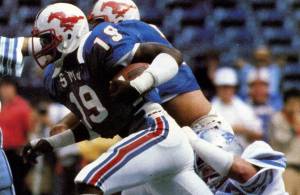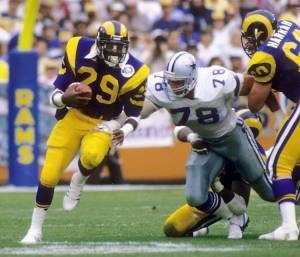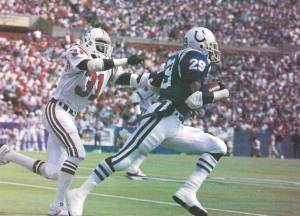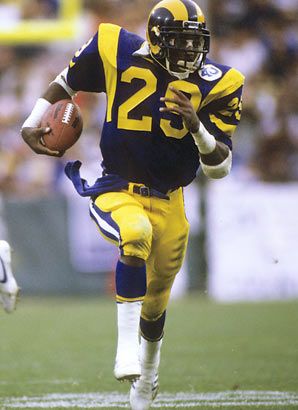When I was living in Texas, I had many occasions to visit Houston. A few miles west of there, on Interstate 10, is the little town of Sealy. It has at least one claim to fame. That’s where Eric Dickerson—the most splendid running back football has ever seen—was born and raised. He led the Sealy Tigers to the 1978 state championship, but that was just in the 2A division. Could he play with the big boys? He was a big boy himself. Recruiters knew talent when they saw it, and Dickerson got the full-court press if I may be forgiven for using a basketball analogy on a football player.
With the Ponies
SMU signed him, and what a career he had. Wearing No. 19, he shared the backfield with another superb runner—Craig James. As much as I hate to regurgitate what some hack in the SMU sports information department came up with, Dickerson and James were called the “Pony Express.” It was certainly the  greatest era in SMU football since Doak Walker in the late 1940s, and that hardly counts since it was in the pre-integration days; there were no Dickersons in the Southwest Conference then. He stood 6′ 3”, weighed 220 pounds and ran the 100 in 9.4 seconds. With the ball in his hands, he was poetry in motion. In my opinion, never before or since has there been a runner quite like Eric Dickerson.
greatest era in SMU football since Doak Walker in the late 1940s, and that hardly counts since it was in the pre-integration days; there were no Dickersons in the Southwest Conference then. He stood 6′ 3”, weighed 220 pounds and ran the 100 in 9.4 seconds. With the ball in his hands, he was poetry in motion. In my opinion, never before or since has there been a runner quite like Eric Dickerson.
The Mustangs’ progression during the Dickerson years is revealing: 5-6 in 1979, 8-4 in 1980, 10-1 in 1981 and 11-0-1 in 1982 as SMU beat Pittsburgh in the Cotton Bowl and finished No. 2 in the nation. Dickerson, who had gained 4,450 yards to top Earl Campbell’s career SWC mark, came in third in Heisman Trophy voting. He and the winner, Herschel Walker of Georgia, make an interesting contrast. While Walker was also big and swift, he ran with no magic. Dickerson was different. It is only a slight exaggeration say that he could make grown men cry.
Come with me back to October 23, 1982. The scene was Memorial Stadium—full house, of course—on the University of Texas campus. It was a gorgeous Indian-summer day. The UT Longhorns entered the game at No. 19, and the Ponies No. 4, but it was all SMU in a 30-17 victory. I was sitting in the north end zone, watching the SMU offense operate in the second quarter. They had the ball on their 25-yard line, facing south when quarterback Lance McElhenny handed off to Dickerson. He got a couple of nice blocks, veered right and was off to the races. This magnificent runner, this long-legged stallion, blazed to a 75-yard touchdown run, and nobody in orange had a chance to catch him. It was a transcendent moment and a fine example of why I continue to love athletics.
At his peak in LA
Selected second overall in the 1983 NFL draft by the Los Angeles Rams, he had a dramatic impact in training camp. His ability, not to mention the beauty with which he ran, dazzled his coaches and teammates. He could take a lickin’ and keep on tickin’.
LA coach John Robinson ran him and ran him and ran him. In his first four seasons, Dickerson (having switched to No. 29) carried the ball nearly 1,500 times and gained about 7,000 yards. But in that stretch of brilliance, there were problems. The frugal Rams did not want to pay him a penny more than his contract called for, so he sat out the first two games of the 1985 season. Then there was the matter of fumbles. Dickerson had a distressing habit of leaving the ball on the ground. In one playoff game, he fumbled thrice and killed LA’s chance of winning. He infuriated old-timers by his loose way of carrying the pigskin. As the fumbles mounted (78 en toto), he made light of it, once saying, “The fumble is just part of my game.” The only running backs with more are Tony Dorsett, Franco Harris, Walter Payton and Greg Pruitt, so you see he was not in bad company.
Dickerson was the main piece of a complicated 10-player, three-team trade, landing in Indianapolis early in the 1987 season. He looked elegant in the Colts’ blue-and-white unis. In the I-formation, hands on his knees before the snap, he looked like a king surveying his realm. He gained 1,659 and 1,311 yards in 1988 and 1989, respectively, but he had lost some zip. Dickerson’s yards-per-carry average was more  pedestrian, and he was not the same guy as before. But in some ways, he had not changed at all. That is, he often complained, got suspended, held out for more money and put self above team.
pedestrian, and he was not the same guy as before. But in some ways, he had not changed at all. That is, he often complained, got suspended, held out for more money and put self above team.
Eric in decline
Traded a second time, he went to the Los Angeles Raiders. Their 1992 training camp included a visit to St. Edward’s University in Austin, where the Dallas Cowboys worked out. I am ashamed to admit I joined a scrum of football fans who sought an autograph from Dickerson. I got one, all right, but it was entirely illegible. I knew that he had signed a million times and probably detested fans, like other big-time jocks did and still do. He showed an occasional flash of brilliance with the Raiders but was a shadow of the young man who had set the NFL on fire. His career ended desultorily as a backup with the Atlanta Falcons. Eric Dickerson a second-stringer!
It is certain that he put up big numbers—13,259 yards and 90 touchdowns. But his teams never won a Super Bowl or even came close. Payton, Emmitt Smith, Barry Sanders, Curtis Martin, LaDainian Tomlinson and Jerome Bettis (all of whom passed him on the career-yardage list) were fine players, but none ran with the grace, speed and élan of Dickerson. He was inducted into the Pro Football Hall of Fame in 1999, his first year of eligibility.


Add Comment